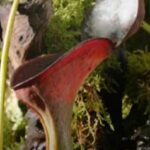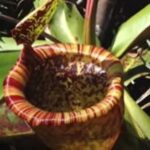As an Amazon Associate, this site earns commissions from qualifying purchases. For more details, click here.
When we hear of pitcher plants, the first thing that springs to mind is that of a meat eater. Their pitchers lure bugs and eat them. While these are efficient carnivores, they do produce flowers which are as exotic and fascinating as the rest of the plant. The process itself is quite interesting.
Pitcher plants bloom in April, producing flowers of different colors such as yellow, white, pink and purple. A healthy pitcher plant can flower without limiting its ability to create traps.
Pitcher Plant Flower Characteristics
Pitcher plant flowers appear from April to May and lasts two weeks. There are some variants however, that produce flowers in the fall. Most of the time though you can expect blooms to manifest in spring.
Sarracenia flowers look like umbrellas that have flipped over. Colors vary, ranging from red, copper, yellow, white, purple, pink in various shades. The stigma and petals may be of a different color than the flower or something similar, it depends on the species.
These flowers sprout on stalks, ranging from 6 inches up to two feet high. After the flower blooms, the stigma becomes responsive for anther pollen. Bees, wasps and other insects can now pollinate, though some pitcher plants are self-fertile.
Sarracenia seed pods have 30-300 seeds. They typically fall near the soil but you can pluck them for propagation.
How Do I Get Pitcher Plants to Bloom?
There are many reasons why a pitcher plant does not bloom. If it is springtime and you do not see any flowers, the plant is probably not getting enough nourishment.
Pitcher plants can flower under the right conditions. They require a humid, sunny location with moist soil and access to insects and other potential prey.
If your pitcher plant is not blooming or used to but no longer does, it could be due to any of the following.
Sunlight. Pitcher plants must be exposed to several hours of sunlight. Direct light is ideal for sarracenia while for nepenthes, partial and direct is better. Nepenthes responds better to grow lights than sarracenia, another reason it is more suited indoors. If have indoor nepenthes we suggest using GE Grow LED Light Bulbs to stimulate growth.
Location. Nepenthes are tropical plants so you can grow them inside your house. Sarracenia require dormancy so they have to be outdoors in winter.
Water. All pitcher plants need moist soil. Unlike sundews or Venus flytraps, you should not sit nepenthes in water. Sprinkle or mist just as you would water the average houseplant.
Humidity. The higher the humidity the better for pitcher plants. The ideal level is 50%, but it also depends on the weather. During hot days you may have to increase it up to 70-80%. You can use a humidifier like the Honeywell Top Fill Tower to control the setting.
Nutrition and food. Pitcher plants manufacture food through photosynthesis, but it still needs nutrients to boost its strength. These plants must eat once a month or up to once a week. Their most common prey are flying and crawling insects. But fish food, frozen and freeze dried bloodworms are also good for them.
Should I Let My Pitcher Plants Flower?
This question often comes up because flowering consumes a lot of energy. Venus flytraps for instance, will have a hard time producing traps if you let it bloom, or even stop altogether. Does this also apply to nepenthes and sarracenia pitcher plants?
Healthy pitcher plants should be allowed to flower. However you should cut the stalk if the flowering process is limiting the number of pitchers the plant produces.
Producing flower and pitchers demand a lot of resources. While cutting off flower stalks will help pitcher plants conserve energy, it is usually not needed. A healthy pitcher plant can bloom and produce pitchers without being stressed.
You may want to prune the stalks if you have a newly divided pitcher plant, but otherwise it should be fine. Grown in the right setting, nepenthes and sarracenia plants will live for several years.
A healthy pitcher plant can grow several flowers without any ill effect. The larger the plant the more flowers it can produce. But if you just divided its rhizome, trim the flower stalk. Flowering will not harm the plant but stalk pruning may increase the pitchers. Trimming is also recommended if you have recently transplanted your sarracenia.
Results may vary, but some sarracenia variants like S. oreophila, S. luecophylla and S. flava benefit from this. The difference between cutting and not cutting flower stalks after a rhizome division is significant. Those that have their stalks pruned can create more pitchers.
Those sarracenia plants produce large flowers so it is not surprising that it affects pitcher production. If you have any of those sarracenia variants and want as many pitchers as possible, trim immediately after a rhizome division. But if you have not performed any division, let the flowers appear.
Are the Pitchers on Pitcher Plants Flowers?
The pitchers on these plants are leaves. They have evolved into a hollow cupped shape called an ascidium. These pitchers perform photosynthesis, water management and other normal leaf functions. But they also have special features to catch and eat prey.
A leaf is attached atop the pitcher, known as a hood or lid. The lid has two functions, to keep rainwater out and conceal the opening below. A bug that lands on top of the hood will not notice the opening underneath it. When an insect falls into the pitcher, the lid makes escape difficult.
The nectar bait is located at the point where the hood and pitcher join up. As the name suggests, sarracenia uses this as a lure for insects. When a bug tries to drink the nectar, it falls in the pitcher. Liquids in the pitcher trap the bug and dissolve it.
Only healthy pitcher plants can bloom so make sure your nepenthes or sarracenia is growing in the right environment. If yours is sick, check out this guide on why pitcher plants die and how to revive them.
Advice For Growing Pitcher Plants
The easiest way to grow pitcher plants is pick one that is local to your region. Growing a pitcher plant that is different from its natural habitat can cause stress and slow its growth. If you want a pitcher plant that grows under specific conditions, you have to simulate that in your home.
Second, you have to recognize the difference between nepenthes and sarracenia. Both are pitcher plants, with similarities and also major differences.
The biggest difference is that sarracenia go dormant in the winter and come back in spring. Nepenthes do not hibernate in winter and will die if left outdoors. This is why they are ideal indoors, though you can keep them outside during spring, summer and fall, at least until it gets too cold.
All pitcher plants grow in moist soil, preferably peat moss and sand. You can plant them in any pot provided it is deep enough. It is also a good idea to put the pot or container atop a saucer full of water to increase moisture.
If you want to grow sarracenia indoors, place the pot near a window so it gets as much light as possible. But even this may not enough. If the plant loses vitality and color, you have to bring it outdoors. Most nepenthes plants thrive inside homes while sarracenia is better suited outdoors.
Some tips for feeding pitcher plants.
- You only need to feed one pitcher at a time. You can also drop a few bugs in a few pitchers. It depends on the size of the prey. The smaller the insect, the more you can give the plant.
- if you are giving it frozen mealworms, thaw them first. You may also add a few drops of water on fish pellets to soften them up.
- A well fed pitcher plant will have a better chance of blooming. The more nutrients a pitcher plant has, the more they can allocate for flowers and pitchers.
Conclusion
Pitcher plants continue to pique our interest because of their unique appearance and behavior. While most are focused on the bug-eating aspects, their flowers deserve attention too, and getting these plants to bloom make them even more appealing.

My fascination with carnivorous plants began many, many years ago with Venus Fly Traps. Now I am more than happy to impart what I know with other enthusiasts and those who are curious about meat eating plants.



